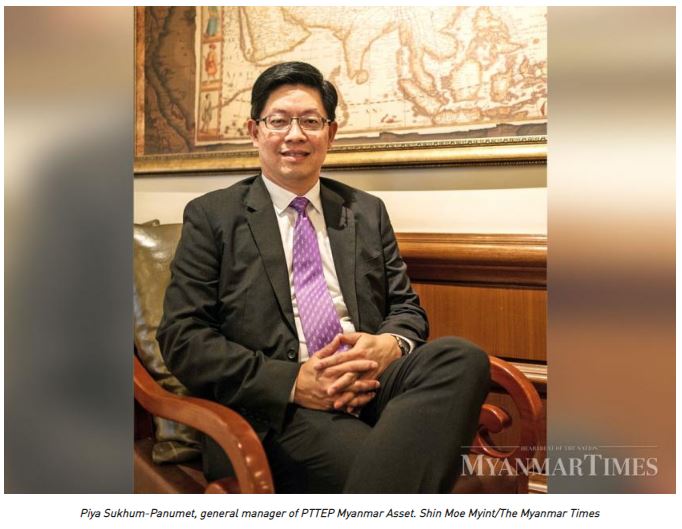PTTEP to invest in new Myanmar gas fields next year
With fresh oil and gas reserves at Myanmar’s offshore blocks now approved for commercial activities, the Ministry of Energy and Electricity (MOEE) will invite international tenders for up to 31 oil and gas exploration fields in early 2019. The last round of exploration and production tenders was held under the former government in 2014.
The aim is to rejuvenate gas production and exports as well as foreign direct investments (FDI). Last year, Myanmar received more than US$3 billion for gas exports, according to the Ministry of Commerce.
Over the same period, FDI decreased to US$900 million to US$5.8 billion due to a lack of investments in the oil and gas sector.
This year though, around 20 oil majors including Thailand’s PTT Exploration and Production Public Company Ltd (PTTEP), Italy’s ENI, South Korea’s Daewoo and Australia’s Woodside will commence seismic surveys and exploratory drilling in several onshore and offshore blocks.
Myanmar is expected to produce 653,300 million standard cubic feet (MMscf) of gas from its four existing gas fields – Shwe, Zawtika, Yetagun and Yadana – this fiscal year, according to government data.
During an exclusive interview with The Myanmar Times last week, Piya Sukhum-Panumet, general manager of PTTEP Myanmar Asset, revealed the Thai oil company’s plans in Myanmar for the year ahead:
What are the current projects PTTEP has in Myanmar?
The company currently has five projects in Myanmar. The first is the Zawtika project in the M-9 offshore block which has started producing gas. The second one is in the M-4 block which is in development stage. The remaining projects: MOGE-3, MD-7 and M-7 are in exploration stage.
What are PTTEP’s future plans in Myanmar? Will it compete in more international bidding rounds?
PTTEP is interested in and keen to participate in offshore oil and gas tenders next year. When the government announces the tenders, we will join the bidding.
What are the challenges faced by the offshore M -9 block of the Zawtika project?
Sand is a feature in the geology of the area and the gas reserves in the field are low. As such, multiple wells have to be drilled in the field. Advanced technology is also needed to separate sand from the natural gas and this adds to the company’s costs.
Are there major differences between Myanmar and other countries in terms of foreign investment in the oil and gas sector?
In Myanmar, the government requires production-sharing contracts and foreign companies always need to work with Myanmar Oil and Gas Enterprise (MOGE) throughout all steps of the process, starting with applying for tenders. In Thailand and other countries, it is investment by a company, so the company runs itself and government isn’t involved. When companies make a profit, they pay royalties to government.
There are four main approaches used around the world when it comes to oil and gas investments: risk agreements, concessions, production-sharing contracts, and service contracts. In Myanmar, the government and MOGE use the production-sharing contract approach where an investor needs to get the government’s approval for the whole project plan. We work with the government in order to achieve mutual benefits.
When calling future international tenders for offshore oil and natural gas blocks, what changes are you expecting from the Ministry of Electricity and Energy?
We are hearing that the government will be conducting negotiations to improve the rules and regulations in the production-sharing contracts. We don’t know the exact details yet and we expect that whatever is announced will benefit investors and the government.
For more foreign investment to flow into Myanmar’s oil and gas sector, what are the changes the government needs to make and what do investors need to prepare for?
In order for investments from foreign companies to enter the country, the government needs to include rules and regulations which are more uniform. For example, if things related to tax and the proportioning of profits are fair then more companies will consider investing in the country.
Before foreign companies enter, they need to study Myanmar’s geography first as there are onshore and offshore [blocks]. So they should decide whether they want to go for one or the other. If they have already selected and researched, then they will already know the blocks they are targeting and this simplifies things when the government calls for international tenders.
What improvements are needed for Myanmar’s oil and gas sector in the future?
Skilled manpower will be crucial. PTTEP Myanmar Assets is passionate about empowering its national staff by providing both internal and external training to improve their technical skills, soft skills and leadership skills. Moreover, the company has initiated its Individual Development Program in Myanmar that will see our workers receiving on the job training for three years in PTTEP Head Office, Bangkok, Thailand.
To build up the domestic industry, Myanmar should also invest in providing its own people with international-standard training and education in the oil and gas sector and building up a skilled pool of talent.
The government has many ministries and they are trying to collaborate more efficiently. It would be better in coming years if they sat down, discussed things and cooperated. If MOGE, Ministry of Labour, Employment and Social Security and other government authorities cooperate more, the approval procedures would be more streamlined.
Secondly, the government is dealing with production-sharing contracts and so, there are more procedures involved. If some rules and regulations were amended and discussions were made, the production-sharing contracts would be clearer and there will be fewer procedures.
I have been working for PTTEP in this country for two years. I see that Ministry of Electricity and Energy is increasingly supportive of working with foreign companies. As the production-sharing contracts have to follow necessary procedures, they used to take a while to get permission in the past. But now it is faster and I hope it will continue.
Source: https://www.mmtimes.com/news/pttep-invest-new-myanmar-gas-fields-next-year.html


 Thailand
Thailand




